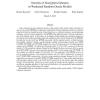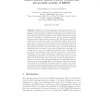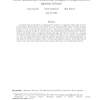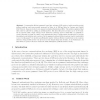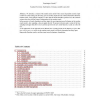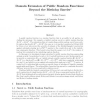PKC
2010
Springer
14 years 11 months ago
2010
Springer
Liskov proposed several weakened versions of the random oracle model, called weakened random oracle models (WROMs), to capture the vulnerability of ideal compression functions, wh...
ASIACRYPT
2000
Springer
14 years 11 months ago
2000
Springer
nded abstract of this work appears Advances in Cryptology — Asiacrypt 2000, Tatsuaki Okamoto, editor, Lecture Notes in Computer Science vol. 1976, Springer-Verlag, 2000. c IACR A...
ASIACRYPT
2003
Springer
15 years 16 days ago
2003
Springer
Abstract. ESIGN is an efficient signature scheme that has been proposed in the early nineties (see [14]). Recently, an effort was made to lay ESIGN on firm foundations, using the...
TCC
2004
Springer
15 years 20 days ago
2004
Springer
In earlier work, we described a “pathological” example of a signature scheme that is secure in the Random Oracle Model, but for which no secure implementation exists. For that...
SACRYPT
2004
Springer
15 years 20 days ago
2004
Springer
A reasonably efficient password based key exchange (KE) protocol with provable security without random oracle was recently proposed by Katz, et al. [18] and later by Gennaro and Li...
CRYPTO
2005
Springer
15 years 26 days ago
2005
Springer
The Full-Domain Hash (FDH) signature scheme [3] forms one the most basic usages of random oracles. It works with a family F of trapdoor permutations (TDP), where the signature of m...
PKC
2007
Springer
15 years 1 months ago
2007
Springer
Abstract. Key-insulated cryptography is a crucial technique for protecting private keys. To strengthen the security of key-insulated protocols, Hanaoka, Hanaoka and Imai recently i...
CRYPTO
2007
Springer
15 years 1 months ago
2007
Springer
We introduce a variant of the random oracle model where oracle-dependent auxiliary input is allowed. In this setting, the adversary gets an auxiliary input that can contain informa...
CRYPTO
2007
Springer
15 years 1 months ago
2007
Springer
A public random function is a random function that is accessible by all parties, including the adversary. For example, a (public) random oracle is a public random function {0, 1}�...
CCS
2007
ACM
15 years 1 months ago
2007
ACM
In this paper we construct two new fuzzy identity-based encryption (IBE) schemes in the random oracle model. Not only do our schemes provide public parameters whose size is indepe...
